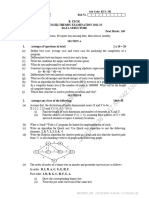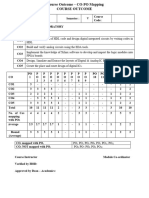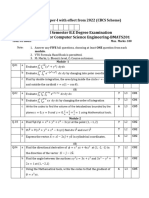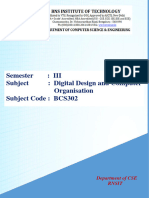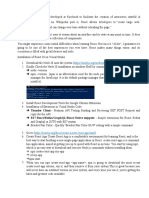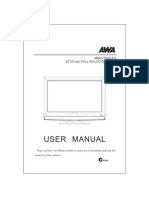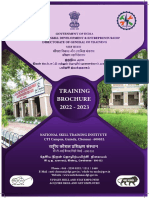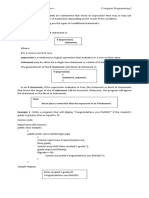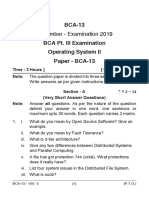13.09.
2023
Operating system Semester 4
Course Code BEC405C CIE Marks 50
Teaching Hours/Week (L:T:P: S) 3:0:0:0 SEE Marks 50
Total Hours of Pedagogy 40 Total Marks 100
Credits 03 Exam Hours 3
Examination type (SEE) Theory
Course objectives:
Understand the services provided by an operating system.
Explain how processes are synchronized and scheduled.
Understand the different approaches of memory management and virtual memory
management,
Describe the structure and organisation of the file system.
Understand inter process communication and dead lock situations.
Teaching-Learning Process (General Instructions)
These are sample Strategies, which teachers can use to accelerate the attainment of the various course
outcomes.
1. Lecturer method(L) need not to be only traditional lecture method, but alternative
effective teaching methods could be adopted to attain the outcomes.
2. Use of Video/Animation to explain functioning of various concepts.
3. Encourage collaborative (Group Learning) Learning in the class.
4. Ask at least three HOT (Higher order Thinking) questions in the class, which promotes
critical thinking.
5. Adopt Problem Based Learning (PBL), which fosters students’ Analytical skills, develop
design thinking skills such as the ability to design, evaluate, generalize, and analyze
information rather than simply recall it.
6. Introduce Topics in manifold representations.
7. Show the different ways to solve the same problem and encourage the students to come
up with their own creative ways to solve them.
8. Discuss how every concept can be applied to the real world - and when that's possible, it
helps improve the students' understanding.
Module-1
Introduction to Operating System: OS, goals of an OS, Computational structures, resource allocation
techniques, efficiency, system performance and user convenience, classes operating system, batch
processing, multiprogramming, time sharing system, real time and distributed operating systems.
(Topics from sections 1.2,1.3,2.2 to 2.8 of text 1).
Module-2
Process Management: OS view of processes, PCB, Fundamental state, Transitions of a process, Threads,
Kernel and User level Threads, Non-Preemptive Scheduling-FCFS and SRN, Preemptive Scheduling- RR and
LCN, Scheduling in Unix and Scheduling Linux .
(Topics from sections 3.3,3.3.1,3.4,3.4.1,3.4.2, Selected scheduling topics from 4.2 and 4.3,4.6,4.7 of
Text 1 )
Module-3
@#12102023
� 13.09.2023
Memory Management: Contiguous Memory Allocation, Non-contiguous Memory Allocation,
Paging, Segmentation with Paging, Virtual Memory Management, Demand Paging, VM Handler,
FIFO, LRU Page replacement policies, Virtual memory in Unix and Linux.
(Topics from Sections 5.5 to 5.9, 6.1 to 6.3 except optimal policy and 6.3.1, 6.7, 6.8 of Text
1).
Module-4
File systems: File systems and IOCS, File Operation, File Organization, Directory Structure, File Protection,
Interface between File system and IOCS, Allocation of disk space, Implementing file access.
(Topics from section 7.1 to 7.8 of Text).
Module-5
Message passing and deadlocks: Overview of Message Passing, Implementing message passing, Mailboxes,
Deadlocks, Deadlocks in resource allocation, Handling deadlocks, Deadlocks detection algorithm, Deadlocks
Prevention.
(Topics from sections 10.1 to 10.3, 11.1 to 11.5 of Text).
Course outcome (Course Skill Set)
At the end of the course, the student will be able to :
1. Explain the goals, structure, operation and types of operating system.
2. Apply scheduling techniques to find performance factors.
3. Explain organization of file system and IOCS.
4. Apply suitable techniques for contiguous and non contiguous memory allocation.
5. Describe message passing, deadlock detection and prevention methods.
@#12102023
� 13.09.2023
Assessment Details (both CIE and SEE)
The weightage of Continuous Internal Evaluation (CIE) is 50% and for Semester End Exam (SEE) is
50%. The minimum passing mark for the CIE is 40% of the maximum marks (20 marks out of 50)
and for the SEE minimum passing mark is 35% of the maximum marks (18 out of 50 marks). The
student is declared as a pass in the course if he/she secures a minimum of 40% (40 marks out of
100) in the sum total of the CIE (Continuous Internal Evaluation) and SEE (Semester End
Examination) taken together.
Continuous Internal Evaluation:
There are 25 marks for the CIE's Assignment component and 25 for the Internal Assessment
Test component.
Each test shall be conducted for 25 marks. The first test will be administered after 40-50% of
the coverage of the syllabus, and the second test will be administered after 85-90% of the
coverage of the syllabus. The average of the two tests shall be scaled down to 25 marks
Any two assignment methods mentioned in the 22OB2.4, if an assignment is project-based then
only one assignment for the course shall be planned. The schedule for assignments shall be
planned properly by the course teacher. The teacher should not conduct two assignments at the
end of the semester if two assignments are planned. Each assignment shall be conducted for 25
marks. (If two assignments are conducted then the sum of the two assignments shall be scaled
down to 25 marks)
The final CIE marks of the course out of 50 will be the sum of the scale-down marks of tests and
assignment/s marks.
Internal Assessment Test question paper is designed to attain the different levels of Bloom’s taxonomy
as per the outcome defined for the course.
Semester-End Examination:
Theory SEE will be conducted by University as per the scheduled timetable, with common question papers for
the course (duration 03 hours).
1. The question paper will have ten questions. Each question is set for 20 marks.
2. There will be 2 questions from each module. Each of the two questions under a module (with a maximum
of 3 sub-questions), should have a mix of topics under that module.
3. The students have to answer 5 full questions, selecting one full question from each module.
4. Marks scored shall be proportionally reduced to 50 marks
Suggested Learning Resources:
Books
1. Operating system – A concept based Approach, by Dhamdhere, TMH, 2nd edition.
Web links and Video Lectures (e-Resources):
https://archive.nptel.ac.in/courses/106/105/106105214/
https://onlinecourses.nptel.ac.in/noc20_cs04/preview
https://onlinecourses.nptel.ac.in/noc21_cs72/preview
https://nptel.ac.in/courses/106106144
https://nptel.ac.in/courses/106102132
https://nptel.ac.in/courses/106106168
https://archive.nptel.ac.in/courses/106/102/106102132/.
@#12102023
� 13.09.2023
Activity Based Learning (Suggested Activities in Class)/ Practical Based learning
Real world problem solving using group discussion.
Role play for process scheduling.
Present animation for deadlock.
Real world example of memory management concepts.
@#12102023












